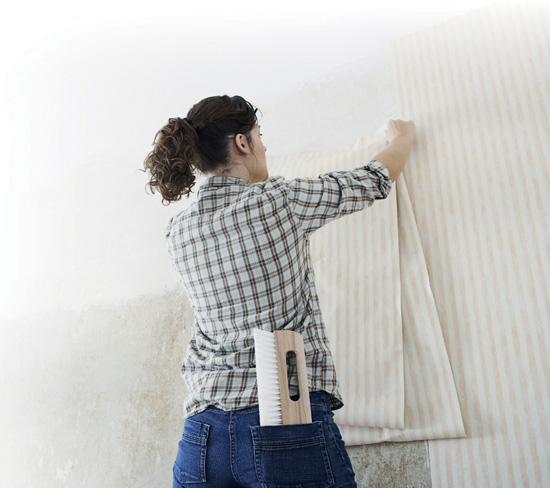The color of this wallpaper works well with the sofa and accessories.
Wallpaper is making a comeback. Not only can it look richer than paint, it gives rooms more dimension and can mask a wall that is uneven. Whether you opt for a muted color or bright patterns, wallpaper should create a unified look with the fabrics and the style of furnishings in a room without overwhelming the space.
Wallpapering is easier than you think. A few tips, some basic instructions and a little imagination are all you need to change the atmosphere of a room.
Wallpaper can have a significant impact on a room. It can subdivide and structure a room, as well as making it appear larger. The trend these days is to wallpaper only one or two walls rather than the entire space.
• Large patterns tend to dominate a room, making them ideal in a big room. In a small room or one full of nooks and crannies they can be overwhelming.
• Cover small rooms with a bright, monochromatic color or small patterns.
• To show off a striking wallpaper pattern to best advantage, the furnishings should be low-key.
• Vertical lines on the wall make low ceilings appear higher, particularly if the ceiling is painted white.
• Before you start, get an idea of how a chosen wallpaper will look by holding a large piece of it against the wall.
• Textured wallpaper covers up small holes or lumps.
• Make a note of the serial or model number of the wallpaper you are buying so that you can find it again if you need more for a perfect match.
• To be sure you have enough, buy an extra roll or two—especially if you can return it if unused.
Making fabric wall panels
By creating fabric panels for walls, you get all the drama of wallpaper but can easily change the patterns and colors.
one Pick up wooden frames for stretching canvas from a craft store (they can be different or uniform sizes) and cut the fabric so it is slightly bigger than the frames.
two Iron the fabric, position it on the frame and tack it down on one long edge with a staple gun.
three Stretch the fabric taut over the frame and staple the opposite long edge, followed by the short sides.
four Finish the corners by folding down the fabric as if wrapping a present, then staple it down. You now have a dramatic wall feature for little money or effort.
Your choice of wallpaper will depend on personal preference and where you will be using it, as well as on the skill of the installer.
• Vinyl wallpaper is easy to handle and stands up to scrubbing and moisture fairly well, so it can be used in bathrooms, kitchens and children’s bedrooms.
• Flocked wallpaper has raised “velvet” patterns and works well for creating decorative highlights and for formal areas such as dining rooms. It is washable, but can be damaged by rubbing and scrubbing.
• Grasscloth, made from a weave of grasses, is better suited to areas that sustain little wear and tear.
• Fabric wallpaper is made of silk, cotton or linen, which is sometimes laminated to regular paper. It’s not the easiest surface to keep clean and is fairly difficult to work with but is stunning in a formal setting, such as a dining room.
• Foil wallpaper is made of patterned metal foil. It can add an interesting touch and reflects light well but is unforgiving if it gets wrinkled or folded.
NEW STYLES AND designs HAVE MADE WALLPAPER popular.
Once you have selected the wallpaper, roll up those sleeves and get to work.
• To remove old wallpaper, pierce it with a scoring tool and moisten it with water. A little white vinegar added to the water acts as a glue solvent.
• Turn off the electricity at the fuse box before moistening wallpaper, as power outlets and light switches can pose a danger.
• Repair holes and cracks in the walls with filler and sand them until smooth.
• Check the undercoat by sticking a piece of tape to the wall and pulling it off with a jerk. If the paint remains on the wall, the wallpaper will stick.
• Sand down painted walls to help the glue stick and eliminate unsightly bumps.
• Apply a coat of primer on dry plaster before beginning so that the wallpaper will stick.
• For a perfect finish, apply lining paper before adding the final paper.
• Repaint the room’s trim and ceilings before you begin wallpapering, and protect furniture and rugs from drips with drop cloths.
• Always begin wallpapering at the edge of a window.
• Using a carpenter’s level or plumb line, draw a vertical line from floor to ceiling as a guide to keep the paper straight. Repeat for each strip.
• Cut lengths of wallpaper about 4 inches (10 cm) longer than the height from ceiling to baseboard.
• Fill a tray with lukewarm water and dip each length of prepasted wallpaper for 30 seconds or more. Change the water every six to eight lengths.
• Match the edge of the first length to the plumb line you have drawn on the wall, leaving 2 inches (5 cm) of extra paper at the top of the ceiling.
• Match patterns exactly, and allow for them when calculating wallpaper amounts.
• Be especially thorough when gluing down the edges and corners of wallpaper seams.
• Trim excess paper at the top and bottom of the wall with a utility knife and ruler.
• Wipe wallpaper and baseboards with a damp sponge to remove excess glue. Rinse the sponge well or streaks will appear as the paper dries.

Draw a vertical line before positioning.